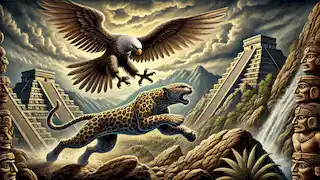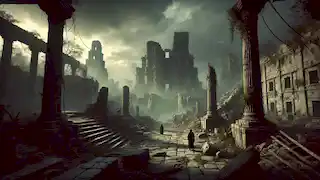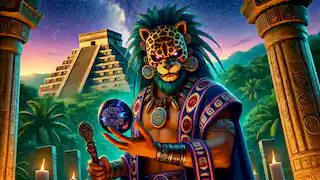In the heart of ancient Mexico, amidst towering temples and lush jungles, there exists a tale that has passed through the ages, retold by poets and priests, whispered by elders to eager ears. It is the legend of Tezcatlipoca, the god of night, sorcery, and the embodiment of conflict. Tezcatlipoca, whose name translates to "Smoking Mirror," was both revered and feared by the Aztecs, his myth interwoven with the cosmos itself.
The gods, believed to reside high above in the heavens, often intervened in the affairs of mortals. Among them, Tezcatlipoca stood out not only for his powers but for his unpredictable nature. Sometimes a trickster, sometimes a ruthless warrior, he would shape the fates of both gods and men. The tale of Tezcatlipoca is one of rivalry, creation, destruction, and redemption—a story that echoes with the triumphs and tragedies of a civilization long gone. The tale begins at the dawn of time when the world was nothing but chaos. Four gods were tasked with creating the earth and sky, each embodying a different aspect of existence. Among them were Tezcatlipoca and his rival, Quetzalcoatl, the Feathered Serpent. Where Tezcatlipoca symbolized darkness, Quetzalcoatl stood for light. They were both complementary and opposing forces, and together they would shape the destiny of the world. Tezcatlipoca, a cunning and ambitious god, sought to impose his will on the universe. In his right hand, he carried an obsidian mirror, which could reveal hidden truths and cast illusions. With it, he manipulated the other gods, playing them against each other to achieve his ends. Quetzalcoatl, on the other hand, sought to bring harmony and order. The tension between them would soon come to a head. The first creation of the world was a failure. Tezcatlipoca ruled as the sun, but his reign was short-lived, as Quetzalcoatl, tired of his brother's arrogance, struck him down. Tezcatlipoca, enraged, transformed into a jaguar and devoured the earth, plunging the world into darkness once more. This marked the beginning of their eternal rivalry, one that would shape the cosmos for eons. Though the first world had been destroyed, the gods were not deterred. They sought to rebuild, this time creating a more lasting world. Quetzalcoatl descended into the underworld to gather the bones of past generations, the remains of the previous ages. He was determined to create humans, beings who would populate the new earth. Tezcatlipoca, however, had his own designs. The underworld was a perilous place, filled with demons and dangers that would test even the gods. Quetzalcoatl's journey was fraught with obstacles, but with cunning and patience, he retrieved the sacred bones. As he was about to return to the land of the living, Tezcatlipoca intervened. Using his obsidian mirror, he conjured illusions that confused Quetzalcoatl. The Feathered Serpent stumbled, shattering the bones into pieces. It was from these fragmented bones that humanity was born—imperfect, fragile, but full of potential. Tezcatlipoca had succeeded in shaping the fate of mankind, ensuring that they would be creatures of both light and shadow, capable of great good but also susceptible to darkness. Thus, the gods breathed life into humans, and the earth was populated once more. Among the mortals, there arose a great city called Tula, ruled by a king who claimed to be the incarnation of Quetzalcoatl. This king was wise and just, leading his people in worship of the gods and building magnificent temples in their honor. Under his reign, the city flourished, its people enjoying prosperity and peace. But Tezcatlipoca, ever the trickster, could not bear to see Quetzalcoatl's influence so strong among mortals. He devised a plan to bring about the downfall of Tula. Disguised as a mysterious traveler, Tezcatlipoca entered the city and began sowing seeds of doubt and discord among its people. He whispered rumors and incited rebellion, turning the citizens against their ruler. The king, Quetzalcoatl's human incarnation, tried to maintain order, but Tezcatlipoca's influence was too strong. One day, Tezcatlipoca approached the king, offering him a gift—a magical drink that would grant him visions of the future. Unbeknownst to the king, the drink was laced with deceit. When the king drank it, he became intoxicated, his judgment clouded. In his weakened state, the king committed acts that dishonored his position, and the people of Tula turned against him. Ashamed and broken, the king fled the city, abandoning his throne. Tula, once a beacon of civilization, fell into ruin, its people scattered to the winds. Tezcatlipoca had triumphed once again, proving that even the most righteous of rulers could fall prey to darkness. Though Tezcatlipoca had orchestrated the fall of Tula, his rivalry with Quetzalcoatl was far from over. The two gods continued to clash, their battles shaping the fate of both mortals and deities. One of the most famous tales of their conflict occurred in the form of a great contest. Tezcatlipoca, in the form of a jaguar, challenged Quetzalcoatl to a race. The prize? Control over the fifth sun, the current age of the world. Quetzalcoatl, taking the form of an eagle, accepted the challenge, confident in his ability to outpace his rival. The race would take them across the heavens, through mountains and valleys, over rivers and deserts. The race was fierce, each god using their powers to gain the upper hand. Tezcatlipoca, with his cunning, created illusions to throw Quetzalcoatl off course. Quetzalcoatl, with his strength, soared higher and higher, trying to escape the jaguar's reach. But Tezcatlipoca, relentless in his pursuit, continued to chase the eagle through the skies. At the final stretch of the race, Tezcatlipoca, using his obsidian mirror, cast a shadow over Quetzalcoatl, blinding him. The eagle faltered, and Tezcatlipoca surged ahead, claiming victory. The jaguar's triumph marked a turning point in their rivalry, as Tezcatlipoca gained control over the fifth sun, the age of the present world. Despite his many victories, Tezcatlipoca's story is not one of pure malice. He was a complex figure, representing the duality of life—the balance between creation and destruction, light and darkness. Though often seen as a villain, he also played a crucial role in maintaining the cosmic order. In the final days of the Aztec empire, as Spanish conquistadors arrived on their shores, the legend of Tezcatlipoca took on new meaning. The fall of the Aztec civilization was seen by many as the fulfillment of ancient prophecies, a sign that the gods had once again intervened in the affairs of men. Tezcatlipoca, with his power over fate, was believed to have a hand in the empire's demise. Yet, even in defeat, the spirit of Tezcatlipoca lived on. The stories of his cunning, his battles with Quetzalcoatl, and his role in shaping the world continued to be told for generations. His legacy, like the jaguar's footprints in the jungle, remained imprinted on the land and the people. In the end, Tezcatlipoca's legend serves as a reminder of the fragility of power and the inevitable cycles of creation and destruction. Though he may have been a trickster and a destroyer, he was also a god of balance, ensuring that the universe would continue to turn, even in the face of chaos.The Rivalry of Gods
The Birth of Humanity

The Fall of Tula

The Jaguar and the Eagle

Redemption and Legacy


















